
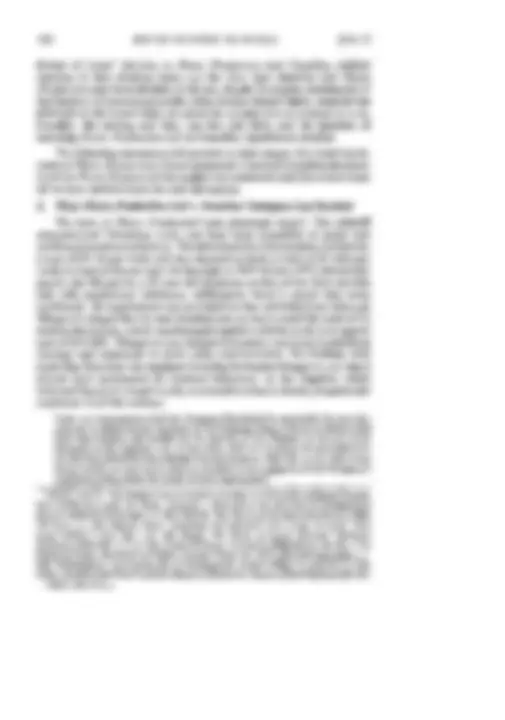
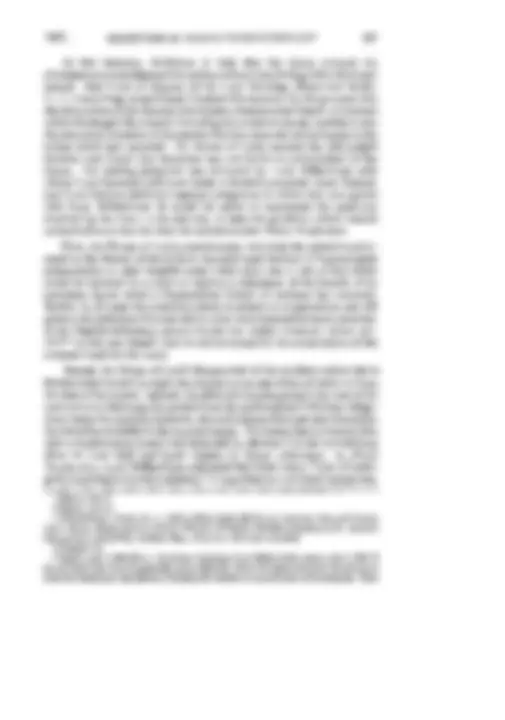
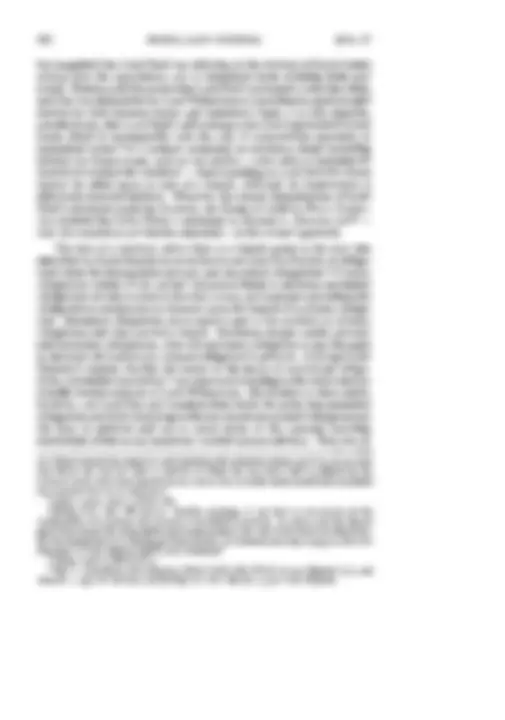

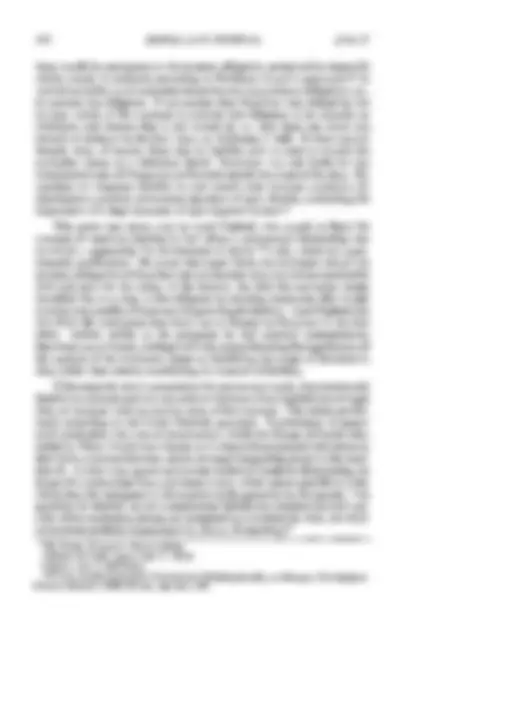

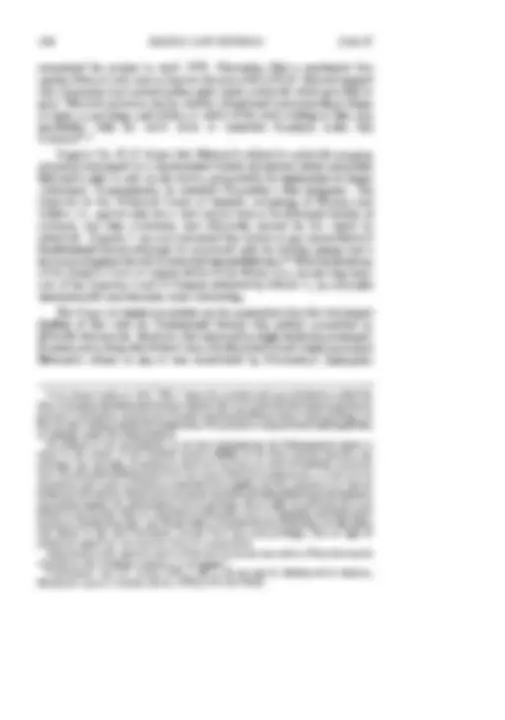
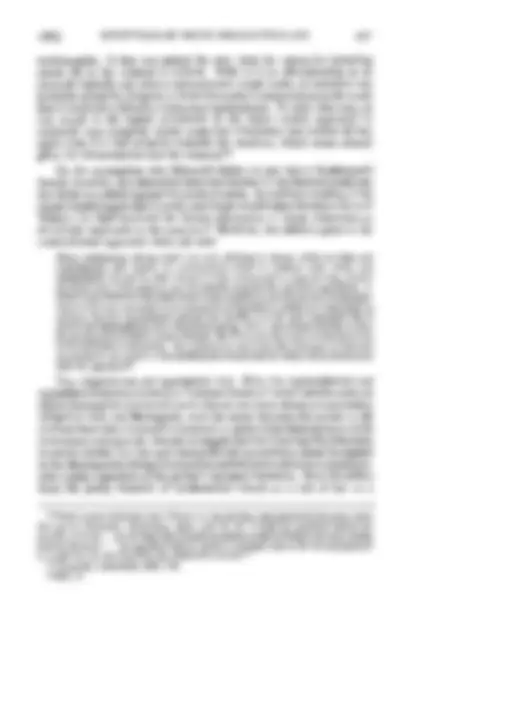
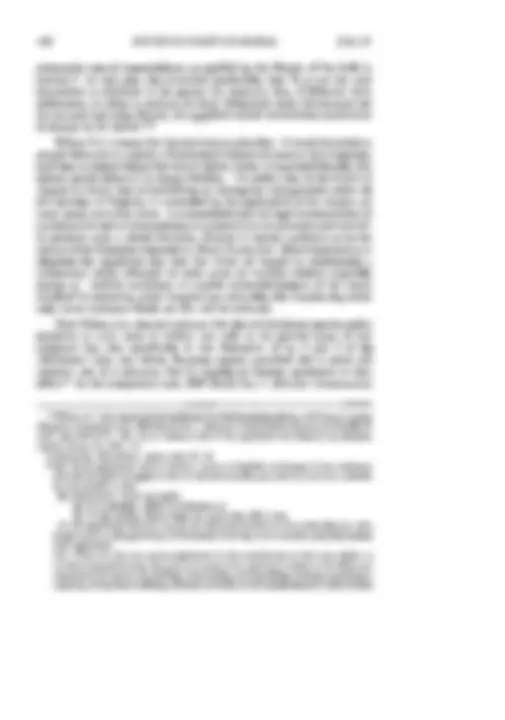
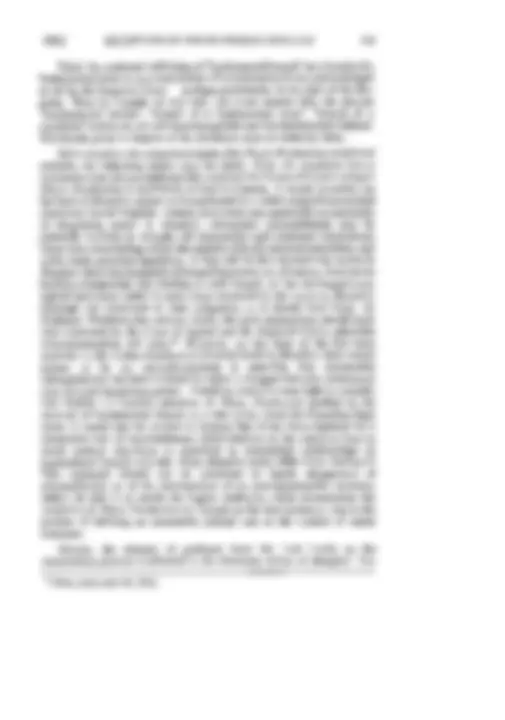
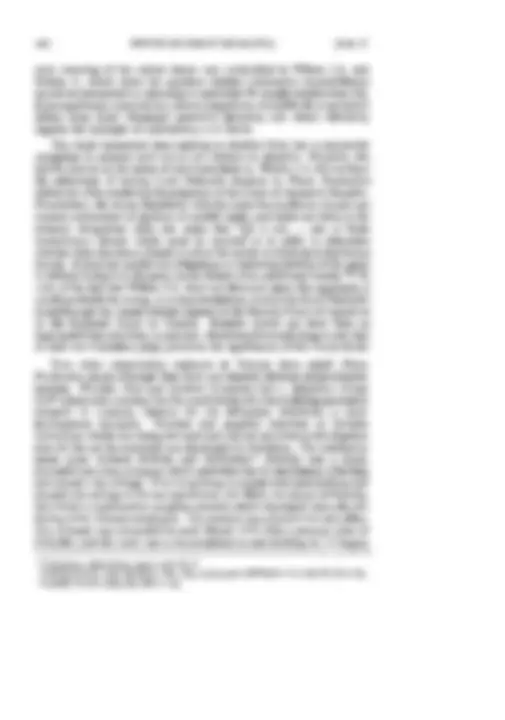
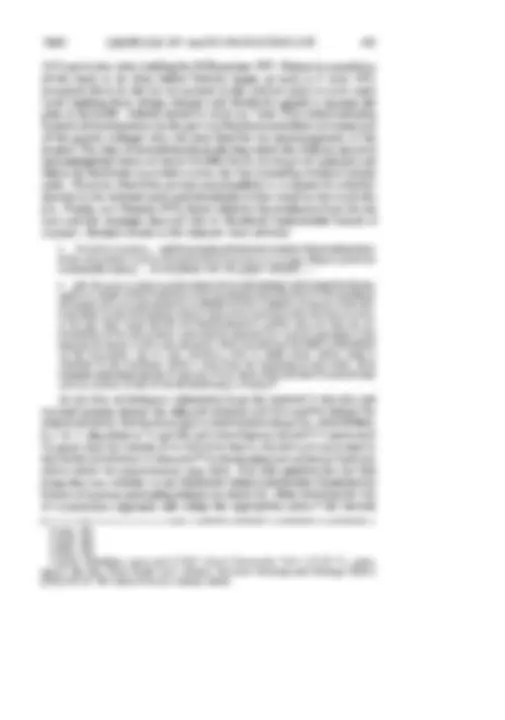
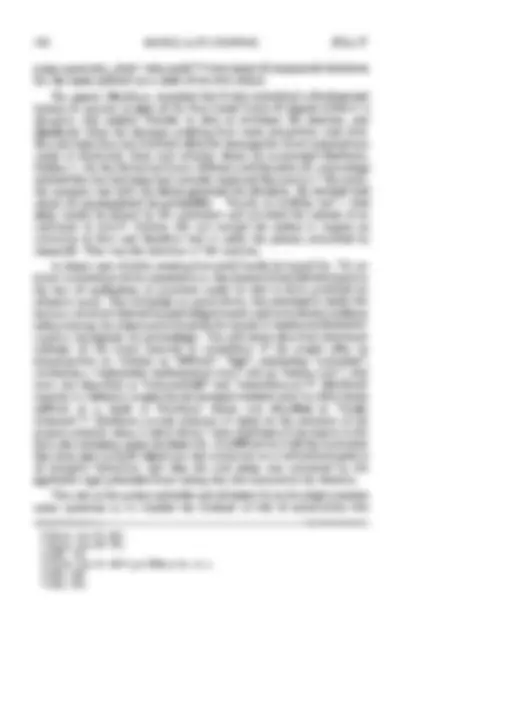
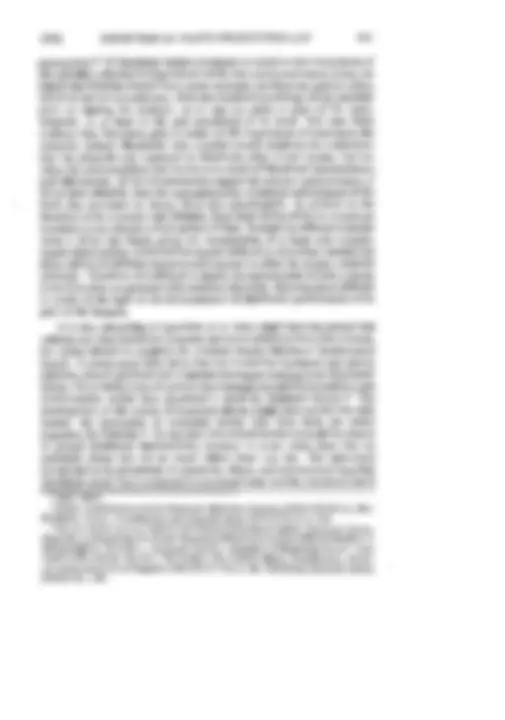
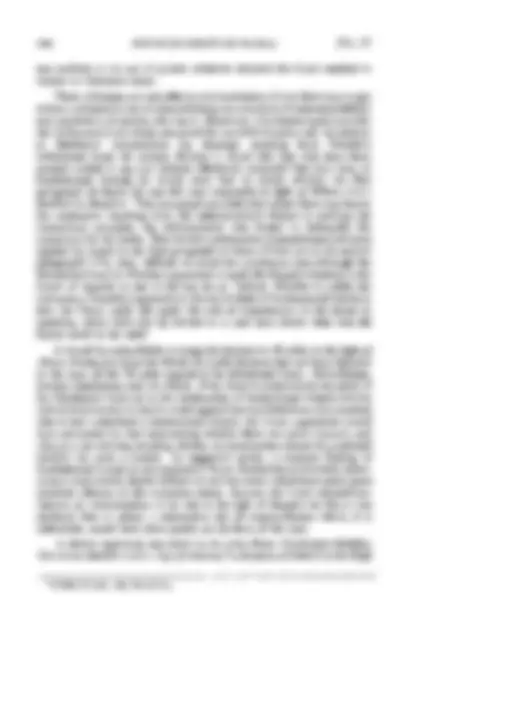
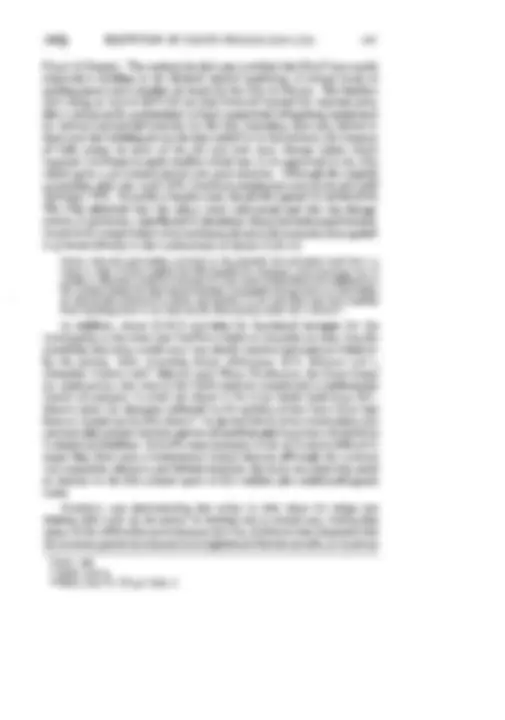
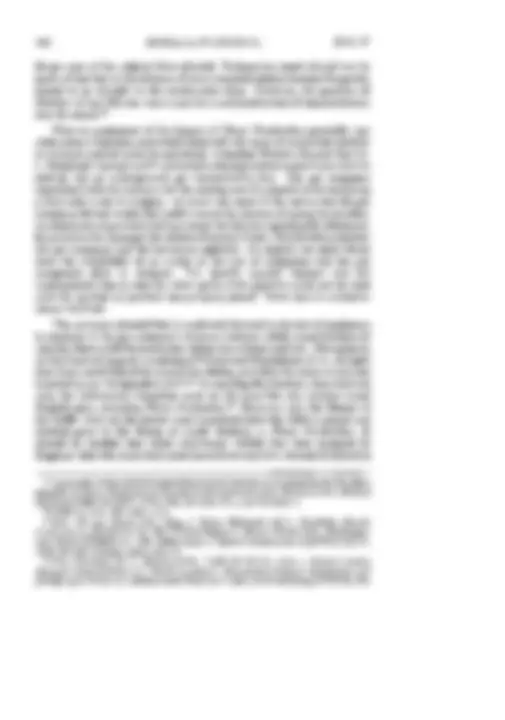

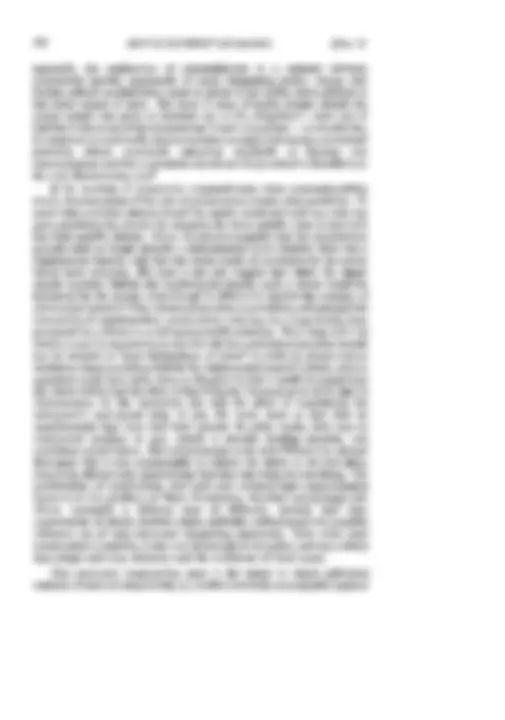
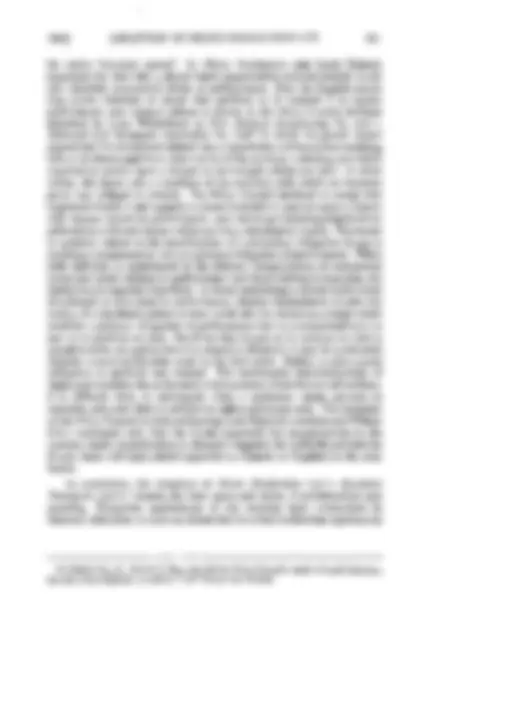



Study with the several resources on Docsity

Earn points by helping other students or get them with a premium plan


Prepare for your exams
Study with the several resources on Docsity

Earn points to download
Earn points by helping other students or get them with a premium plan
Community
Ask the community for help and clear up your study doubts
Discover the best universities in your country according to Docsity users
Free resources
Download our free guides on studying techniques, anxiety management strategies, and thesis advice from Docsity tutors
The judicial approach to exclusion clauses in contract law, focusing on the House of Lords' decision in Photo Production and its impact on Canadian law. how the courts have dealt with exclusion clauses in the context of fundamental breaches and the concept of unconscionability. It also highlights the unresolved issues surrounding the construction of exclusion clauses and their impact on primary obligations. valuable insights into the evolving nature of contract law and the role of the judiciary in ensuring fairness and reasonableness in commercial transactions.
What you will learn
Typology: Summaries
1 / 29

This page cannot be seen from the preview
Don't miss anything!






















M.H. Ogilvie*
Introduction
***** Of the Department of Law, Carleton University. This paper was delivered at the Eleventh Annual Workshop on Commercial (^) and Consumer Law held at the Faculty of Law, University of Toronto, 22-3 October 1981. IA superb analysis of the trends in the modern law of obligations is found in P.S. Atiyah, The Rise and Fall of Freedom of Contract (1979). See also P.S. Atiyah, From Principlesto Pragmatism, Inaugural Lecture delivered before the University of Oxford on 17 February 1978, and Reiter, The Control on Contract Power (1981) 1 Oxford J. of (^) Legal Studies 347 and the references cited therein.
RECEPTION OF PHOTO PRODUCTIONLTD
The express espousal of a public policy of redressing bargaining imbal- ances was not made in the past by judges who nevertheless implicitly adopted the principle when applying the construction rules, the contra proferentem rule or the doctrine of fundamental breach of contract. How- ever, Lord Denning M.R. has been less reticent in explicitly advocating a judicial role in redressing grievances arising from marketplace inequalities. Other judges have increasingly proved willing to adopt expressly the rubric of inequality of bargaining power without expressly searching too deeply into its meaning in written decisions on the facts before them. It is widely accepted that judicial pronouncements should not be in the vanguard of social engineering, and with few exceptions judges subscribe to the view that the law ought to reflect rather than shape socio-economic (^) changes. Yet it seems clear that the willingness of the judiciary to acknowledge, if hesitantly, that the law should play a role in the protection of the less powerful in the marketplace, indicates judicial perception that the time has come (^) for the assessment of contractual relationships in terms of basic fairness and justice in the use of socio-economic advantages, rather than in terms of a systematic complex of rules founded upon the principle (^) of freedom of contract, too often enjoyed by one party (^) only. In any case, the legislators have now given the required lead. Pastjudicial equivocation in acknowledging the "rise and fall of freedom of contract" is perhaps best exemplified in the two steps forward and one
Socitj d 'Armement Maritime S.A. v. N. V. Rotterdamsche Kolen Centra-
Production Ltd v. Securicor Transport Ltd,^5 as well as in the Canadian responses to those decisions which have paid lip service to one principle while applying the other (^) without acknowledgement. 6 The effect of the
2[1956] I W.L.R. 936 (C.A.). 3[1967] (^) I A.C. 361 (H.L.). 4[1970] (^1) Q.B. 447 (C.A.). 5[1980] A.C. 827 (H.L.), (^) rev'g [1978] 1 W.L.R. 856 (C.A.). 6The Supreme Court of Canada approved the rule of construction approach of Suisse Atlantique in B.G. Linton ConstructionLtdv. C.N.R. Co. [1975] 2 S.C.R. 678. However, other courts have been unwilling to uphold exclusion clauses on construction if they were unfair; see, e.g., Lightburn v. Belmont Sales Ltd (1969) 6 D.L.R. (3d) 692 (B.C.S.C.); R. G. McLean Ltd v. Canadian Vickers Ltd [1971] 1 O.R. 207 (C.A.); Canso Chemicals Ltd v. Canadian Westinghouse Co. (1975) 10 N.S.R. (2d) (S.C., App. Div.). See also the comments of S. Waddams, The Law of Contracts (1977), 285 et seq., and Ziegel, Comment (1979) 57 Can. Bar Rev. 105, 109, where he notes that the Canadian lower courts have "paid lip service to the House of Lords' (^) constructional rule but, with surprising ease, almost unfailingly managed to find that the parties could not have intended the clause to apply to a fundamental breach. Suisse At/antique changed the form of judicial reaction to disclaimer clauses but not its substance."
1982]
RECEPTION OF PHOTO PRODUCTION LTD
At first instance, McKenna J. held that the clause covered the circumstances and dismissed the action without any finding of fundamental breach. The Court of Appeal, led by Lord Denning, (Shaw and Waller LL.J. concurring) unanimously reversed this decision on the grounds that the destruction of the factory constituted a fundamental breach of contract which discharged the contract including the exclusion clause, (^) and that it was the presumed intention of the parties that the clause should not apply in the events which had occurred. The House of Lords restored the trial judge's decision and found that Securicor was not liable on construction of the clause. The leading judgment was delivered by Lord Wilberforce with whom Lord Scarman and Lord Keith of Kinkel concurred. Lord Diplock and Lord Salmon delivered separate judgments in which they too agreed with Lord Wilberforce. It would be useful to enumerate the questions resolved by the Law Lords and also to state the problems (^) which remain unresolved now that the dust has settled around Photo Production.
First, the House of Lords unanimously (^) overruled the principle advo- cated by the Master of the Rolls in Karsales^9 and Harbutt's, 10 and adopted subsequently in other English cases,"I that there was a rule of law which could be invoked by a court to deprive a defendant of the benefit of an exclusion clause where a fundamental breach of contract has occurred. Rather, in all cases the exclusion clause (^) is subject to construction and will protect the defendant if construed to cover the events which have occurred. If the English defendant cannot invoke the Unfair Contract Terms Act, 197712 on his own behalf, then he will be bound by the construction of the
contract made by the court.
Second, the House of Lords disapproved of the corollary notion that a fundamental breach brought the contract to an end either ab initio or from the date of the breach. Instead, the effect of a breach going to the root of the contract is to discharge the parties from the performance of further obliga- tions under (^) the contract; however, the contract survives and may determine the remedies available to the innocent party. The heresy that a contract dies with a fundamental breach had been said in Harbutt's to be derived from dicta of Lord Reid and Lord Upjohn in Suisse Atlantique. In Photo Production, Lord Wilberforce conceded that there was a "note of ambi- guity or perhaps even inconsistency ",13 especially in Lord Reid 'sjudgment, 9 Supra, note 2. 10 Supra, note 4. 1 Charterhouse Credit Co. v. Tolly [1963] 2 Q.B. 683 (C.A.); (^) Kenyon, Son and Craven Ltdv. Baxter Hoareand Co. [1971] 1 W.L.R. 519 (Q.B.); Wathes (Western) Ltdv. Austin's (Menswear) Ltd [1976] 1 Lloyd's Rep. 14 (C.A.), were all overruled. 12Chapter (^) 50. 13 Supra, note 5, 842 (H.L.). In Suisse Atlantique (^) Lord Reid stated, supra, note 3, 398: "I do not think that there is generally much difficulty where the innocent party has elected to treat the breach as a repudiation, bringing the contract to an end and sue for damages. Then
1982]
Mc GILL LAW JOURNAL
but suggested that Lord Reid was referring to the recovery of future losses arising after the repudiation, not to immediate losses resulting from past events. Putting aside the points that Lord Reid's statement is less than clear, and that it is undesirable for Lord Wilberforce to introduce an unwarranted distinction here between future and immediate losses, it is still arguable, paradoxically, (^) that Lord Reid is advocating a rule of law approach to future losses which is incompatible with the rule of construction approach to immediate losses.' 4 If a contract contained an exclusion clause excluding liability for future losses, such as lost profits- even when a fundamental breach of contract has occurred - then according to Lord Reid the clause cannot be relied upon in case of a breach, although on construction it effectively excluded liability. Whatever the correct interpretation of Lord Reid's statement might be, however, the House of Lords in Photo Produc- tion decided that Lord Porter's statement in Heyman v. Darwins Ld 5 - that the contract is not thereby rescinded- is the correct approach.
The fate of a contract where there is a breach going to the root was described by Lord Diplock in terms borrowed from the civil law of (^) obliga- tions when he distinguished primary and secondary obligations. 6 Primary obligations consist of the parties' reciprocal duties to perform; secondary obligations are said to arise in the event of non-performance and include (^) the obligation to compensate an innocent party for breach of a primary (^) obliga- tion. Secondary obligations are as much a part of the contract as primary obligations and they survive a breach. Exclusion clauses modify primary and secondary obligations, often the secondary obligation to pay damages in the event of a breach of a primary obligation to perform. Although Lord Diplock's analysis clarifies the nature of the status of contractual obliga- tions, it is neither innovative, 7 nor does it add anything to the more conven- tionally worded analysis of Lord Wilberforce. Clarification is often (^) useful, however, and Lord Diplock's analysis does clarify the point that secondary obligations and their modifying exclusion clauses are as much obligations as the duty to perform and are as much terms of the contract imposing contractual duties as any positively worded contractual duty. (^) They are, in
the whole contract has ceased to exist including the exclusion clause, and I do not see how that clause can then be used to exclude an action for loss which will be suffered by the innocent party after it has ceased to exist, such as loss of profit which (^) would have accrued if the contract (^) had run its full term." 14Atkin, supra, (^) note 7, 437-8, 442. 15[1942] A.C. 356, 399 (H.L.): "Strictly speaking, to say that on acceptance of the renunciation of a contract the contract is rescinded is incorrect. In such a case the injured party may accept the renunciation (^) as a breach going to the root of the whole consideration. By that acceptance he is discharged from further performance and may bring an action for damages, but the contract itself is not rescinded." 16 Supra, note 5, 848-9 (H.L.). (^17) See C. Czarnikow Ltd v.Koufos [ 1966] 2 Q.B. 695, (^725) (C.A.) per Diplock L.J., and Moschi v. Lep Air Services Ltd [1973] A.C. 331, 350 (H.L.) per Lord Diplock.
[Vol. 27
REVUE DE DROIT DE McGILL
for the validity of exclusion clauses may have survived because only Lord Diplock expressly disapproves of it, when he states that a court is not entitled "to reject the exclusion clause, however unreasonable the court itself may think it is, if the words are clear and fairly susceptible to one meaning only." 22 If it does survive then it would appear to operate where the parties are of unequal bargaining power or where they cannot evoke the statutory reasonableness provided by the Unfair Contract Terms Act, 1977. The statements by both Lord Wilberforce and Lord Diplock that commercial men bargaining on equal terms should be free to establish their own quidpro quo and to apportion their losses serve to cut down the number of situations in which exclusion clauses^ would^ be^ subjected^ to^ a^ reasonableness^ test.^ (^23) If reasonableness has indeed survived, then the longer effect of Photo Produc- tion may be to replace fundamental (^) breach as a legal technique for the control of exclusion clauses with a doctrine of unconscionability. This aspect of the case will be particularly important in jurisdictions lacking unconscionability legislation or legislation restricting the application of unconscionability to certain categories of contracts, such as consumer con- tracts. 24 At present the survival of reasonableness is less important in England than in Canada where most provincial legislation ignores exclusion clauses in standard-form contracts. Second, if the correct judicial approach to exclusion clauses (^) arising in a free bargaining context (^) is simply one of construction, the House of Lords provided little guidance to the construction process itself. To say that clear exclusion clauses are to be enforced ignores the fact that problems arise because clauses are not clear. The courts have neutralized the simple clear construction rule by the development of other construction principles such as the contraproferentem rule, the rule that business efficacy should be given to the contract, or the rule that exclusion clauses (^) should not be construed so as to reduce the primary obligations to mere declarations of intent. 25 The manner in which the House of Lords construed the disputed clause itself provides an illustration, in that little discussion was (^) directed to the words in the clause which clearly stated that Securicor was liable for losses resulting solely (^) from the negligence of its employees acting within the course of their employment. Perhaps Lord Wilberforce's (^) handling of the question of whether negligence included deliberate acts and his invocation of the contra proferentem rule to conclude that deliberate acts were included are indicative of future difficulties. 26 Since there had never been a finding that Musgrove
(^22) Supra, note 5, 851 (H.L.). 2Ibid., 844 and 851 respectively; some limits (^) of the necessity for a test of reasonableness are found 24 in Suisse Ailantique, supra, (^) note 3, 406 per Lord Reid. Ogilvie, supra, note 7, 113-4; Ziegel, supra, note 7, 430-3. (^25) See Ziegel, supra, (^) note 7, 433-8. (^26) Supra, note 5, 846 (H.L.): "Whether (^) in addition in negligence, [the clause] covers other, e.g., deliberate acts, remains a matter (^) of construction requiring, of course, clear words. I am
[Vol. 27
RECEPTION OF PHOTO PRODUCTION LTD
deliberately intended to destroy the factory, Securicor could not be made liable. First year tort students mindful (^) of the standard definition of negligence given by Winfield and Jolowicz27 would find Lord (^) Wilberforce's liberal interpretation puzzling. Further difficulties seem to arise with respect to whether Musgrove's actions were within the scope of his employment. Lord Denning was adamant that they were not, yet the House of Lords apparently assumed that, but for the exclusion clause, Securicor was liable for its employees. Definition (^) of what constitutes "within the scope of employment" would have been useful here. If the learned Law (^) Lord's efforts are indicative of clear contractual construction, then lamentably they leave much to be desired and provide little, if any, guidance for future courts, dependent as they are on Lord Wilberforce's reading into the clause of concepts which arguably are not there. Third, the House of Lords was divided as to the nature of Securicor's original liability. Lord Diplock held that the source of its (^) liability was contractual, arising from the promise that its employees would exercise reasonable skill and care. The other four Law Lords held that although one source of liability was contractual, had it not been for the exclusion (^) clause, Securicor would also have (^) been vicariously liable in tort for Musgrove's actions on the strength of Morris v. C. W. Martin and Sons Ltd. 28 The majority assumption was that Musgrove's deliberate throwing of the match, regardless of the (^) final outcome of that act, was within the scope of his employment thereby making Securicor vicariously liable, despite the fact that he had deliberately departed from the exercise of reasonable skill and care in guarding the factory. The majority apparently implied a (^) primary obligation that Securicor would exercise reasonable skill and care in patrol- ling the factory whereas the actual contractual obligation was (^) the somewhat less onerous one of using due diligence in employing persons who would use reasonable skill and care; that primary obligation was not breached so that, but for the exclusion clause, Securicor would have been liable. (^) Lord Wilber- force stated that there (^) was indeed an implied obligation, although the precise nature of that obligation was not expressed. 29 However, such an implied
of the opinion that it does, and being free to construe and apply (^) the clause, I must hold that liability is excluded." 27 W. Rogers, Winfield and Jolowicz on Tort, 1 Ith ed. (1979), 66: "Negligence as a tort is the breach of a legal duty to take care which results in damage, undesired by the defendant, to the plaintiff." 28[1966] (^) I Q.B. 716 (C.A.). In Photo Production, Lord Salmon's words could be construed to support vicarious liability (^) only when he says, supra, note 5,852 (H.L.): "There can be no doubt that but for the clause in the contract which I have recited, Securicor would have been liable for the damage which was caused by their servant, Musgrove, whilst indubitably acting in the course of his employment [ See Morris v. C. W. Martin & Sons Ltd [1966] 29 I Q.B. 716 (C.A.)]." Supra, note 5, 846 (H.L.).
1982]
RECEPTION OF PHOTO PRODUCTION (^) LTD
Fourth, the primary issue of the role of an exclusion clause generally is also raised in Photo Production in the light of Lord Diplock's analysis just outlined. While only one (^) Law Lord apparently espoused the view advocated by Professor Coote in 1964, 34 the question of whether this constitutes (^) an important breakthrough arises. English academic (^) commentators, such as Yates and Palmer,^35 have adopted this view as has Kerr J.36 In (^) Australia, where the doctrine of fundamental breach never (^) gained acceptance, the idea that exclusion clauses could modify primary (^) obligations has also found judicial approval. 37 The conventional (^) view that exclusion clauses are not contractual terms in the sense that they impose obligations meant that judges (^) interpreted their role in the contract as defensive only, to provide a shield behind (^) which the defendant could hide and escape the responsibilities which (^) would normally flow from his breach of contract. Judicial (^) technique in dealing with exclu- sion clauses was summed up by Denning L.J. (^) (as he then was) in Karsales thus: "The thing to do is to look at the (^) contract apart from the exempting clauses to see what (^) are the terms, express or implied, which impose an obligation on the (^) party."^38 Judicial adoption of a procedural rather than a substantive approach to exclusion clauses was attacked (^) by Professor Coote on the ground that, taken to its logical (^) conclusion, the parties were being permitted to create (^) valid contractual rights and duties and at the same time also permitted to make their contractual undertakings unenforceable. The creation of unenforceable rights has often been said to be contrary to the spirit of the common law, 39 and (^) as Devlin J. has said, is not to create a contract at all. (^40) Where they are appropriate then, exclusion clauses may (^34) Supra, note 30. It is, perhaps, not insignificant (^) that Coote divides contractual obligations (^) into primary and secondary rights in the first chapter of his book. (^35) D. Yates, Exclusion Clauses in Contracts (1978); (^) Palmer & Yates, supra, note 7. 36 Trade and (^) TransportInc. v. ino Kaiun Kaisha Ltd (The Angelia) [1973] 1 W.L.R. 210, 230 (Q.B.); Lord Wilberforce's decision in PortJackson (^) Stevedoring Pty Ltd v. Salmond & Spraggon (Australia) (^) Pty Ltd (The New York Star) [1980] 3 All E.R. 257, 259 (P.C.) suggests some (^) ambiguity as to whether Lord Diplock's analysis has found support from the Privy Council. 37 The Council of the (^) City ofSydneyv. West (1966) 114 C.L.R. 481,495 (^) (H.C. Aust.)per Kitto J.; State Government Insurance (^) Office (Queensland) v. Brisbane Stevedoring Pty Ltd (1969) 38 123 C.L.R. 228, 243 (H.C. Aust.) per Barwick C.J. Supra, note 2, 940; (^) see also Istros v. Dahlstroem [1931] 1 K.B. 247,252-3per (^) Wright J. which was cited with approval in G.H. Renton & Co. v. Palmyra (^) Trading Corp. [ 1956] 1 Q.B. 462, 507 (C.A.) per Hodson L.J. 39 F. Bohnen, Studies in the Law of Torts(1926), 445, cited by Coote, supra, note 30,7; see also p. 5, fn. 23 of Coote's text, for a list of English cases on the issue. 40 Firestone Tyre Co. v. Vokins & Co. [1951] 1 Lloyd's Rep. 32, 38 (K.B.): "The position then would be that the lightermen have said: 'We will deliver your (^) goods; we promise to deliver your goods at such and such (^) a place, and in the condition in which we receive them; but we are not liable if they are lost or damaged from any cause whatsoever.' That is not in law a contract at all. It is illusory to say: 'We promise to do a thing, but we are not liable (^) if we do not (^) do it.' If the matter rested there, there would be nothing in the contract."
1982]
REVUE DE DROIT DE McGILL
operate to place substantive limitations or^ to^ define^ the^ primary^ obligations found in other clauses in the contract and^ would^ prevent^ the^ right^ to^ use^ the exclusion clause as a defence^ from^ accruing^ in^ the first^ place.^ Professor Coote provides the following example:
Suppose, for example, that I sell a horse which I say is sound forjumping, but provide in a written agreement that I accept no responsibility whatever if the horse should prove unsound. What I am doing is to ensure that the purchaser has no primary contractual right to call for a horse which is sound forjumping. I am not contracting that the horse is sound and giving myself a shield in case of breach. I am simply refusing to contract on the point at all. This is not to say that I am under no duty, but my duty is a moral one binding in^ honour^ only.^4 The contract^ in^ Photo^ Production^ did^ not^ go so^ far^ as^ to^ create^ repug- nancy between^ the primary^ obligation^ of^ providing^ security^ services^ and^ the exclusion clause which established the degree of skill and care as one of due diligence in hiring employees who were to exercise reasonable skill and care in their duties. The effect of the exclusion clause was to modify what would otherwise have been the implied term that Securicor was to exercise reaso- nable skill and care. More accurately, according to Lord Diplock's analysis, the exclusion^ clause^ established^ by^ an^ express^ term^ the^ standard^ of^ care contracted for^ by^ the^ parties,^ thereby^ precluding^ the^ implication^ of^ a stand- ard. No^ breach^ of^ the^ express^ standard^ occurred:^ Securicor^ had^ investigated Musgrove's background sufficiently. Adoption of the Coote thesis on the facts of^ Photo^ Production would mean^ that^ the^ express^ terms^ of^ the^ contract were enforced,^ and^ more^ significantly,^ that^ the^ doctrine^ of^ freedom^ of contract was upheld. It is no wonder that Lord Diplock was the only judge to overrule^ expressly^ a^ substantive test^ of^ reasonableness;^ his^ judgment^ is^ all of a^ piece.^ But^ the^ same^ conclusion holds^ true^ for^ illusory^ contracts^ where the clauses are totally repugnant. If there is no contract to enforce in the first place, the right^ to^ rely^ on the^ exclusion^ clause^ as^ a^ defence^ does^ not^ accrue. Therefore, there is no need for a doctrine of fundamental breach nor a substantive test of reasonableness to cope with situations thought to be inherently unfair.^ Restitution^ is^ sufficient.^ Ironically,^ then,^ the^ only^ situa- tions in which a substantive doctrine of reasonableness or unconscionability might serve the ends ofjustice would be where the express terms interpreted ii la Coote-Diplock create contractual obligations^ which^ may^ indeed^ be repugnant to commonly held views as to what is permissible public conduct in the making of contracts. Thus, if there is a role for unconscionability it will operate, despite the implied intention of the Coote thesis to eliminate it, as a branch of the doctrine of illegality; it is against public policy or morality to permit parties^ to^ contract^ on^ such^ terms,^ whether^ they^ are^ of^ equal^ bargain- ing power^ or^ not.^ There^ is^ no^ need,^ then,^ to^ enact sophisticated unconscion- ability tests. Rather, a simple statement of the existence of the legal concept 4 1 (^) Coote, supra, note 30, 7.
[Vol. 27
Mc GILL LAW JOURNAL
completed the project in April 1975. Chomedey filed a mechanics' lien against Belcourt and sued to recover the sum of $51,553.32. Belcourt argued that Chomedey had waived its lien rights under (^) article (6) which provided in part: "The subcontractor hereby waives, releases and renounces all privileges of rights or privilege, and all lien or rights of lien now existing or that may
Contract". Fogarty Co. Ct J. found that Belcourt's refusal to make the progress payments amounted to a fundamental breach of contract which precluded Belcourt's right to rely on the waiver, purportedly by application of Suisse Atlantique. Consequently, he awarded Chomedey a lien judgment. The majority of the Divisional Court of Ontario, consisting of O'Leary and Linden JJ., agreed that there had indeed been a fundamental breach of contract, but that Chomedey had effectively waived its lien rights (^) by
fundamental breach although he concurred with his brother judges that a personal judgment should be awarded against Belcourt. 45 With the decisions of the Ontario Court of Appeal delivered by Wilson J.A. (as she then was), and of the Supreme Court of Canada delivered by Ritchie J., (^) an otherwise unremarkable case becomes more interesting. The Court of Appeal proceeded on the assumption that the trial judge's finding of fact that the fundamental breach was indeed committed by Belcourt was correct. However, that assumption might easily be questioned. It seems more likely that (^) if there was a fundamental breach which provoked Belcourt's refusal to pay it was constituted by Chomedey's inadequate
44 The clause continues, ibid., 720-1: "upon the premises and upon the land on which the same is situated, and upon any money or monies due to or to become due from any person or persons to Contractor, and agrees to furnish a good and sufficient waiver of the privilege and lien on said building, lands and monies from every person or corporation furnishing labour or material under the Subcontractor. In addition to the requirements as set forth hereinabove, the Subcontractor agrees to waive to the extent of one hundred percent (100%) of the final contract amount, any privilege, lien and right of preference which he may have or which he hereafter may have upon the aforesaid building and/ or the land upon which it is constructed as a result of or in connection with work to be done or materials to be supplied by him, and moreover, that (^) he holds and will hold the Owner and Contractor harmless and indemnified from and against a registration against the said property of any privilege, lien or right of preference by or on behalf of any person, firm or corporation performing work or supplying materials under authority derived from him, and, if and when so required by the Contractor, he will obtain and deliver to the said Contractor, releases from any such privileges, liens or right of preference signed by such persons, firms or corporations. Subcontractor also agrees to waive all liens and to execute any waiver of liens that may be required 45 by the mortgage company or mortgagee." Mechanics' Lien Act, R.S.O. 1970, c. 267, s. 40; see also D. (^) Micklem & D. Bristow, Mechanics' Liens in Canada, 3d ed. (1972), 9-10 and 378-81.
[Vol. 27
RECEPTION OF PHOTO PRODUCTION LTD
workmanship. If that was indeed the case, then the reason for including article (6) in the contract is evident. While^ it^ is^ so^ all-embracing^ as^ to preclude virtually any claim a subcontractor might^ make,^ its^ inclusion^ was probably primarily designed to limit Chomedey's remuneration in the event that it tendered a defective contractual performance. To infer otherwise, as one would if the logical conclusion of the higher court's approach to article (6) were accepted, would^ mean^ that^ Chomedey^ had^ waived^ all^ lien rights even if it had properly installed the windows, which seems absurd given the circumstances and^ the^ contract.
4 6
On the assumption that Belcourt's failure to pay was a fundamental breach, however, the substantive issue was whether or not Belcourt could^ use the clause as^ a^ shield^ against^ Chomedey's^ claim.^ An^ ordinary^ reading^ of^ the clause would suggest that it could, and that it would indeed be able to do so if Wilson J.A. had honoured her formal affirmation of Suisse Atlantique as the proper approach to^ the question.^47 However,^ she^ added^ a^ gloss^ to^ the constructional approach^ when^ she^ said: Many exclusionary clauses (and I am now referring to clauses which are clear and unambiguous and require no construction) which in isolation seem unfair and unreasonable are^ not^ so^ when^ viewed^ in^ their^ contractual^ setting^ and^ may,^ indeed, constitute part of the quidpro quo for benefits received through hard negotiation. It seems to me, therefore, that what we are to ask ourselves is not whether the exclusionary clause is fair and reasonable in^ its^ contractual^ setting (this^ is,^ indeed,^ to^ be^ assumed^ in^ a contract between sophisticated parties) but whether it^ is^ fair^ and^ reasonable^ that^ it survive the disintegration of its contractual setting. If it is, then presumably that is what the parties must be taken to have intended. But if it is not, then such an intention is^ not to be attributed to the parties. The question for the Court then becomes: is it fair and reasonable in the context of this fundamental breach that the waiver^ of^ lien^ continue^ to bind the appellant? 48 Two observations^ are^ appropriate^ here.^ First,^ the unprecedented^ and unjustified distinction between a^ "contract^ situation"^ which^ subsists^ and^ one which disintegrates^ ignores^ the^ point^ that^ an^ exclusion^ clause^ as^ a^ secondary obligation does not disintegrate; until the issues between the parties to the contract have been resolved it is incorrect^ to^ speak^ of^ the^ disintegration^ of^ the contractual setting at all. Second, to suggest that the Court has the discretion to decide whether it is fair and reasonable^ that^ an^ exclusion^ clause^ be^ applied in the disintegrated setting is to sanction judicial intervention in a contractual relationship regardless of the parties' expressed intentions. How this differs from the^ policy^ function^ of^ fundamental^ breach^ as^ a^ rule^ of^ law^ or a
46 There is some indication that Wilson^ J.A.^ (as^ she^ then^ was)^ perceived^ this^ point^ when she says^ in^ Chomedey^ Aluminium,^ supra,^ note^ 43,^ 10:^ "I^ think^ the^ appellant^ waived^ the security of its lien^ ..^ on^ the^ basis^ that^ progress^ payments^ would^ be^ being^ made^ on^ a^ regular basis by Belcourt .... The appellant had no^ reason to anticipate^ that^ as^ the work^ progressed it would ever be out of pocket any substantial amount." 47 Chomedey Aluminium, (^) ibid., 5-8. 48 Ibid., 8.
1982]
RECEPTION OF PHOTO PRODUCTIONLTD
(Ottawa) Ltd, Linden J. in the Divisional Court, dealing with an identical article (6) in the light of s. 5(1) held that once the parties had effectively contracted out of the Act, then^ the^ lien^ was^ forever extinguished.^ He^ stated that there^ was^ no inequality^ of^ bargaining power^ here^ and^ no^ need^ to^ invoke the doctrine^ of^ fundamental breach.^ Indeed,^ he^ said^ that^ if^ waivers^ were upset by a fundamental breach, "[t]hey could never be relied upon".^52 While one might have thought that the legislature had expressed its^ intention to permit contracting out of liens fairly clearly and that Linden J.^ had^ correctly interpreted that intention, Wilson J.A.^ asserted^ that^ still^ clearer^ words^ were required. She said, "[ilt seems to me^ that^ the^ Legislature^ could^ not^ have intended to introduce such disparity into the position of the^ contracting parties, i.e., that one party could be assured that, irrespective of^ the^ non- performance by^ him^ of^ any^ of^ his^ contractual^ obligations,^ the other party's waiver of lien would continue to bind him."^53 Although^ mindful^ of^ the desirability that^ waivers^ be^ reliable,^ Wilson^ J.A.^ surmised^ that^ had^ that^ been the specific public interest^ in^ the^ mind^ of^ the^ legislature,^ it^ would^ have prescribed a statutory waiver form rather than^ consigning^ the^ issue^ to^ the contractual context and the vagaries of the common law of contract. To expect that the legislators should be required to go to such lengths^ seems unrealistic, if not ridiculous; indeed, as Linden^ J.^ suggested,^ it^ seems^ that they could not have permitted a voluntary contracting out of a lien more clearly. Linden J.'s^ approach^ acknowledged^ legislative^ intention^ to^ permit freedom of contract^ whereas^ Wilson^ J.A.'s^ did^ not.^ Instead,^ she acknowledged the existence of a judicial discretion to assess legislative intention in the light of good public policy as to judicial intervention in^ the free bargaining contractual process. The conclusion that Wilson J.A. is^ a tacit advocate of judicial intervention is inescapable. More problematical and regrettable still is the too brief adoption of this decision in the light of the subsequently decided Photo Production by^ the Supreme Court of Canada. Ritchie J., for the Court, expressly adopted^ the Court of Appears interpretation of s. 5(1) 5 4 and further, simply^ concurred with "Madam Justice Wilson [who] adopted the same considerations as
for any owner, contractor or subcontractor by virtue thereof has a^ lien^ for^ the^ price^ of the work or material upon the estate or interest of the owner in the land,^ building, structure or works and appurtenances and the land occupied thereby or enjoyed therewith or upon or in respect of which the work is done, or upon which^ the materials are placed or furnished to be used, limited, however, in amount to the sum^ justly^ due^ to the person entitled to the lien and to the sum justly owing, except^ as^ herein^ provided,^ by the owner, and the placing or furnishing of^ the^ materials^ to^ be^ used^ upon^ the land^ or such other place in the immediate vicinity of the land designated by the owner or his agent is good and sufficient delivery for the purpose of this Act, but delivery on the 52 designated^ land^ does^ not^ make^ such^ land^ subject^ to^ a^ lien. Supra, note 49, 609. 53 Chomedey (^) Aluminium, supra, note 43, 10. 54 Beaufort Realties, ibid., 725-6.
McGILL LAW JOURNAL
those which governed the House of Lords in the Photo case in holding that the question of whether such a clause was applicable where there was a fundamental breach was to be determined according to the true construction of the contract." 55 How the^ decision^ of^ the^ Court^ of^ Appeal^ in^ Beaufort^ and the decision of the House of Lords in Photo Production can be so easily reconciled is baffling! Assessment of the decisions of Wilson J.A. and Ritchie J. in the light of the four^ resolved^ and^ four^ unresolved^ issues^ after^ Photo^ Production, insofar as they relate to Beaufort, reveals some confusion. With respect to the resolved issues considered seriatim, the following observations may be made. First, the concept of fundamental breach operating as a rule of law undermines the Canadian judgments despite lip service to the principle that the exclusion clause should^ be^ subjected^ to^ strict^ construction^ only.^ The Canadian approach continues to be one of deciding first whether the events constitute a fundamental breach of contract, whatever that might be, and then of deciding whether^ the^ exclusion^ clause^ is^ relevant. In^ contrast,^ Photo Production appears to suggest that it is not necessary to decide at all whether there has been a fundamental breach of contract. Rather, it is enough to construe the exclusion clause to^ decide^ whether^ or not^ it^ contemplated^ and provided for the events which have^ occurred.^ There^ is^ no^ need^ to denominate a fundamental breach^ at^ all,^ unless,^ of^ course,^ the^ exclusion clause clearly operates where there has been a fundamental breach of contract, so that one must determine whether the events constitute such a breach. Beaufort, then, suggests a Canadian failure to understand that once the rule of construction approach has been^ adopted^ the^ concept^ of fundamental breach is eliminated along with the rule of law concept. The rule of construction operates^ like^ Occam's^ razor.^
56
Second, while Wilson J.A. correctly stated that one effect of a fundamental breach is to discharge the parties from further performance of the primary obligations, she did not appreciate that the so-called secondary obligations subsist and are to be applied, according to Photo Production, to determine the final^ allocation^ of^ loss^ and^ damages^ between the parties. Unlike even Lord Denning in Photo Production,^57 she does not anywhere in her judgment specifically construe the contract nor come close to acknowledging what would appear to most reasonable people to be the clear intention of article (6). Rather, after formal adoption of Suisse Atlantique, she then proceeds to the reasonableness issue. The fundamental perception that the exclusion clause is part and parcel of the bargain, is lacking.
55 Ibid., 725. (^56) Nunquam ponenda est pluralitassine necessitate. 1 Sent. d. 27, q. 2k (1497). (^57) Supra, note 5, 864 (C.A.).
[Vol. 27
REVUE DE DROIT DE McGILL
clear meaning of the waiver clause was overlooked by Wilson J.A. and Ritchie J., which raises the question whether substantive reasonableness should be interpreted as operating to neutralize the simple construction rule. If reasonableness operated as a neutralizing factor, it is difficult to see how it differs from Lord Denning's presumed intention rule which effectively negates the principle of construction & la Suisse. The third unresolved issue relating to whether there was a concurrent obligation in contract and tort is not relevant to Beaufort. However, the fourth issue as to the status of the Coote thesis is. Wilson J.A. did not have the advantage of having Lord Diplock's decision in Photo Production before her when rendering the judgment of the Court of Appeal in Beaufort. Nonetheless, she shows familiarity (^) with the thesis that exclusion clauses can contain contractual obligations or modify rights and duties set down in the primary obligations when she states that "[i]t is not, ... one of those exclusionary clauses which must be resorted to in order to determine whether there has been a breach at all or the extent to which there has been a breach. It does not modify the obligation or restrict the liability of the party in default: it deprives the party not in default of an additional remedy." 59 In view of the fact that Wilson J.A. does not elaborate upon this approach, it would probably be wrong, or at least premature, to state that Lord Diplock's breakthrough has found (^) judicial support in the Ontario Court of Appeal or in the Supreme Court of Canada. Beaufort would not have been an appropriate fact situation, in any case. However, it is comforting to note that at least one Canadian judge perceives the significance of the Coote thesis. Two other construction contracts in Ontario have raised Photo Production issues although they have not inspired detailed jurisprudential analysis. Woollatt Fuel and Lumber (London) Ltd v. Matthews Group Ltd 60 concerned a contract for the construction of a two-building apartment complex in London, Ontario for the defendant Matthews, a local development company. Woollatt had supplied materials to Debuka Enterprises which was doing the work and was not involved in the litigation once its lien on the materials was discharged by Matthews. The substantive issues arose between Debuka and Matthews. 6 ' Debuka was a small, successful one-man company which specialized in the installation of lathing and acoustic tile ceilings. Prior to agreeing to supply and install lathing and acoustic tile ceilings in the two apartments, Mr Slade, the owner of Debuka, was shown a construction progress schedule which stipulated, inter alia, the timing of the Debuka subproject. The schedule was posted in the site office. The contract was concluded in early March 1973 with a contract price of $152,000, and the work was to be completed in one building by 13 August
59 Chomedy Aluminium, supra, note 43, 9. 60 (1979) 25 O.R. (2d) 730 (H.C., Div. Ct), rev'g in part (1978) 18 O.R. (2d) 454 (Co. Ct). 61(1978) 18 O.R. (2d) 454, 455 et seq.
[Vol. 27
RECEPTION OF PHOTO PRODUCTIONLTD
1973 and in the other building by 31 December 1973. Delays in completion of the work to be done before Debuka began, as early as 5 June 1973, prompted Slade to ask for an increase in the contract price to cover extra work resulting from design changes and Matthews^ agreed^ to^ increase^ the price to $155,349. Debuka started to work on 7 July 1973, behind schedule because of incompetence on the part of a Matthews subsidiary company and of the project manager who was later fired for his mismanagement of the project. The delay of several months in starting meant that^ Debuka^ incurred uncontemplated losses of about $15,000 due to shortages of materials and failure by Matthews to provide a crew, thereby increasing Debuka's labour costs. However, Matthews proved unsympathetic to a request for a^ further increase in the contract price and threatened to hire someone else to do the job. Finally, on 4 January 1974, Slade withdrew his employees from the site and sued for damages incurred due to Matthews' fundamental breach of contract. Several clauses in the contract were relevant:
At the time of Debuka's withdrawal from the contract it was two and one-half months^ behind the^ adjusted^ schedule^ and^ five^ months^ behind^ the original schedule. Matthews sought to shield behind clause (4), which Killeen Co. Ct J. described as "a specific and unambiguous clause"; 63 it purported "to grant only the remedy of an extension time to the sub-contractor and its last words are absolute in character" 64 in discharging the contractor from any claims which the subcontractor^ may^ have.^ The^ only^ question^ for^ the^ trial judge then was whether or not Matthews' delays constituted a fundamental breach of contract precluding reliance on clause (4). After adopting the rule of construction approach and citing the appropriate cases, 65 the learned
62Ibid., 461. 63 Ibid., 462. 64Ibid., 65 463. Suisse Atlantique, supra, note 3; B.G. Linton Construction Ltd v. C.N.R. Co., supra, note 6. See also Perini Pacific Ltd v. Greater Vancouver Sewerage and Drainage District [1967] S.C.R. 189 which involved a similar clause.
1982]